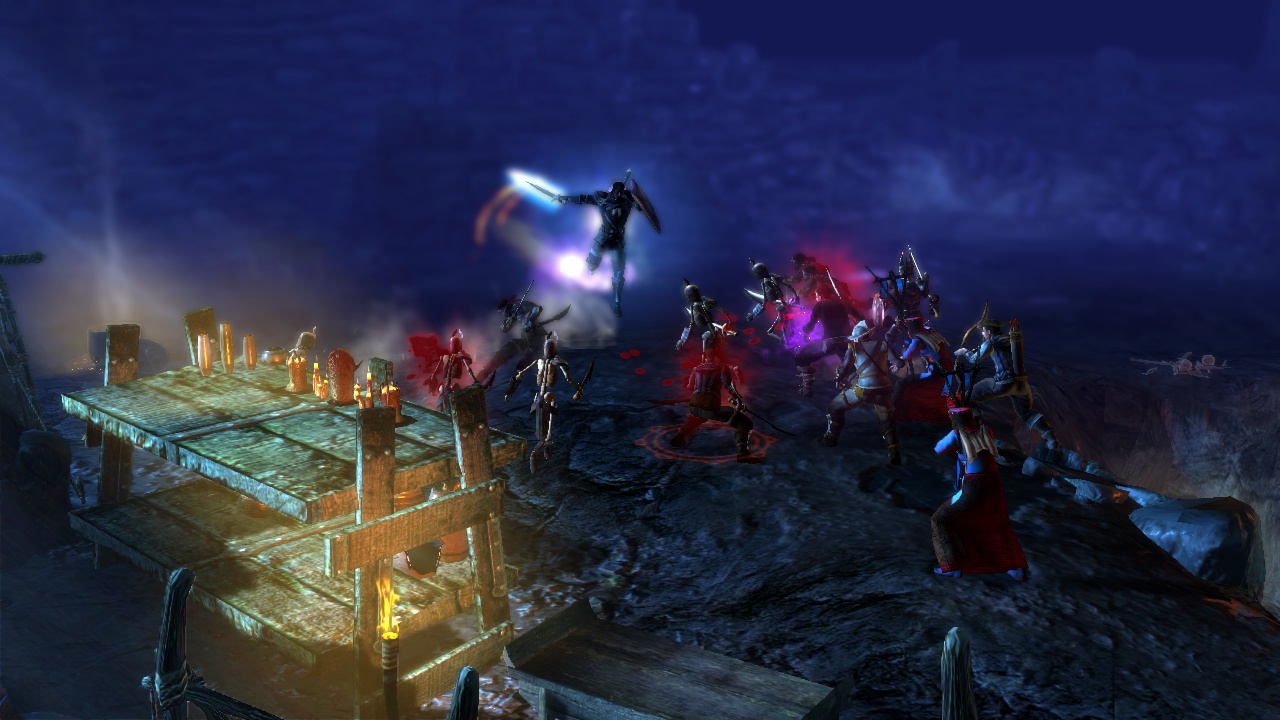
And lo, in the Kingdom of Ehb, at a time of warring factions, the weakened King did fall. And the King's daughter, the beautiful Jeyne Kassyndar, didst blame the 10th Legion, the warriors who had, in previous games, been known for their excellent fighting skills, pulling offst such tricks as the shield bash and swordrelated shit that gave rise to a “whoa” from nearby peasants. And Jeyne went off on a massive one, and didst hunt down the 10th Legion across the lands, diverting funds that couldst, truth be told, more effectively have been spent on public services.
That's the rough story behind Lucas Montbarren, son of a tenth legionnaire, and the hero I was allowed to play in the first hands-on of the new Dungeon Siege game. With the blessing and occasional advice of Chris Taylor and original developers Gas Powered Games, development duties have passed to Obsidian – the prince regents of taking another company's IP baton and running with it. PC exclusives such as Neverwinter Nights, revered shared platform classics like Knights of the Old Republic, and emotional reunions with their prodigal Vault Boy – Obsidian are sequel masters.
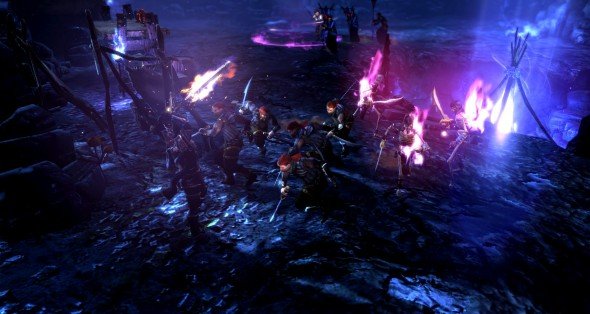
This is, however, the first time they've taken a well-loved – or at least, remembered-with-a-fond-nostalgicsquint – PC exclusive, and folded it into the shape of a gamepad. So they're going to have to bear in mind that entitled pricks like me are going to want to talk about whether they're dumbing the game down. It's slightly disappointing to learn that the mouse and keyboard controls haven't been calibrated to the point where they're willing to let outsiders play on them, but the game's only at pre-alpha.
The young Montbarren's early life was one of training and fear, because his camp was constantly discovered by Kassyndor's forces. One day, by methods no one's going into, given that these guys were on the run and everything, a man called Odo sent a message to the scattered survivors and told them to meet in the spookiest old house in the Kingdom of Ehb. There was a grave matter of the utmost peril and urgency, and he wasn't even joking.
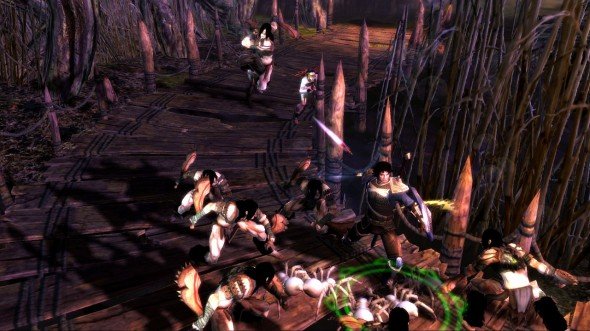
This is a hero-led game. There are no classes. That ballsy statement boils down to something substantially less brassy – there's no class selection screen. Of course, Lucas has a fighting style that's analogous to familiar classes – a warrior by any other name would smell as sweet, and still wields two-handed weapons. As a melee fighter, Lucas can distribute his skill points into three stances – onehanded weaponry, two-handed kit and a healing defensive stance. Invest points in defence and you'll have a Paladin-esque tank. Otherwise, it's the warrior's path of damage-dealing melee.
The early levels gave me access to three of Lucas' powers, with six more opening up at higher levels. The one-handed shield bash stuns an enemy, while the two-handed version charges you into the thick of the action, dealing damage to anything in the way. Take the healing stance and you can regenerate some health while dodge-rolling around like a drunkard.
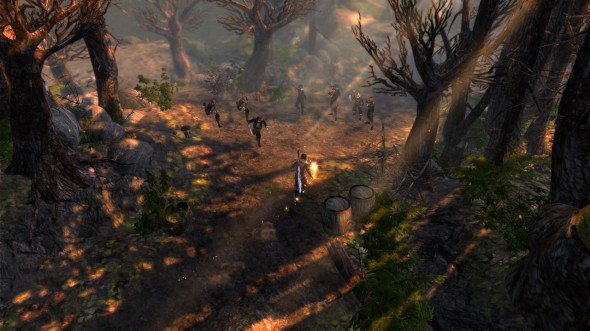
This is limited only by your focus bar, which is regenerated by landing your regular attacks, forcing you to keep going back into the action. So, while DSIII doesn't have the strategic depth or character development of Diablo, that's not where Obsidian want to go. There's the unexpected tinge of an action game.
The biggest gaming news, reviews and hardware deals
Keep up to date with the most important stories and the best deals, as picked by the PC Gamer team.
As they sallied forth into the verdant green forest – not the spooky purple barren forest that would probably come a few levels on – the Montbarren child stumbled across a mound of abandoned barrels. He licked his lips. It hadth been minutes since his last chest, and the old hunger for a nice new set of pauldrons was returning. Praying that he werest not observed, he gave the stacks of crates and coopery a right royal swording, good and proper. And lo, there was a bit of gold that no one seemed to be using.
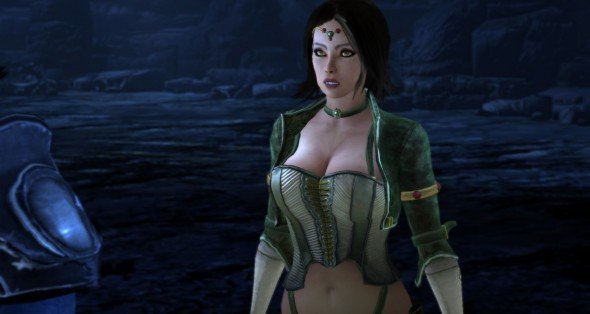
I've got Nathan Davis, associate producer, sitting with me during my limited-time play-through, so I'm trying to strike a balance in my crawling behaviour. Do I spin the camera to peer down every potentially chest-filled nook, or would that look like I was lost? Do I take on the side-quests? Does Nathan even know how much I love chests?
He's a patient man, but as I walk past another stack of barrels and crates, he chokes on his own compulsion. “I swear, if you don't smash up that pile of stuff...” Let's not forget the loot. Loot is important. I question the lack of adjectives on the items I find – “Deadly Greatsword” seems slightly less prosaic than, say, Blizzard's fruit machine of loot names. With curiosities such as the Jeweller's Sturdy Pauldrons of the Owl in the wider gaming world, surely a Deadly Greatsword seems a little dull?
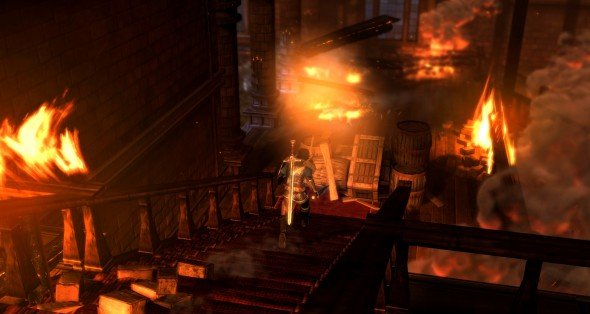
Loot, explains Davis, is only gently randomised. Some stats will be different from game to game, but not names, and many of the items – particularly rare ones – are hand-placed. There are no level limitations, either: this is because the loot will be tailored to your level. It's a philosophical thing: Dungeon Siege III isn't about endlessly replaying on the offchance of finding better gear or another flawless gem: it's about playing through the story, with or without a friend.
Dungeon Siege's re-jigged combat can quickly swap between two attack stances – one-handed and two-handed. Doing so instantly changes your weapon to suit. You also have a defence stance. Each stance has its own set of three special attacks, which unlock over time. The novice one-handed attack lets you use a shield bash for crowd control. The novice two-handed lets Lucas charge into (or out of) the action. The defensive stance allows you to cast a light regeneration spell. These actions are limited only by Lucas's focus, which doesn't regenerate, but can easily be built up by using his regular attacks. So, if you're going to wimp out and run away, make sure you've got enough focus to heal before you do.
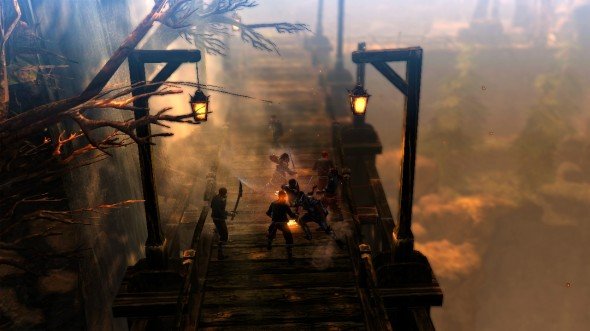
Each of the character's nine skills has two branches, on which you can spend talent points. It's a familiar range of buffs: boosted crits, increased stun chances, higher healing rates. However, it doesn't make sense to spread them around too thinly – you get an extra bonus for maxing out a particular talent.
So, your reading skill will not increase by one. This is a simplified system, completing Dungeon Siege's migration from Oblivion-esque 'jump while you walk' levelling in the field to an exclusively skill-point menu-based development system. It's a process that began in the second game – Obsidian have just concluded the process.
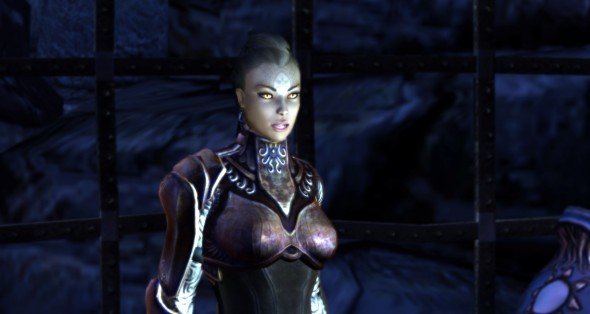
Obsidian's president, Feargus Urquhart, talks about how the developer is finding a balance. His own career's been pretty illustrious. From Interplay to Black Isle, he oversaw Fallout 2 and the critically acclaimed reading game Planescape Torment. He described how Dungeon Siege has had to change slightly to suit a multiformat release.
“It's direct control versus mouse click. As soon as you make that change, a lot of time is spent on how it feels. The idea isn't to turn it into an action game like Ninja Gaiden or a Devil May Cry, but you don't want it to feel like there's no action, which is why we've added a lot of combos.” The “combos” that Urquhart mentions aren't a huge list of light-heavy timing combos – instead, they're automatic animations that trigger on your third attack. “And then, blocking and rolling, they're not RPG skills, and we've included them, too. In a lot of action RPGs, particularly on the PC, you run after something and you just hit it. Don't get me wrong: I'll play any of those, even the bad ones! But that's not what this is.”
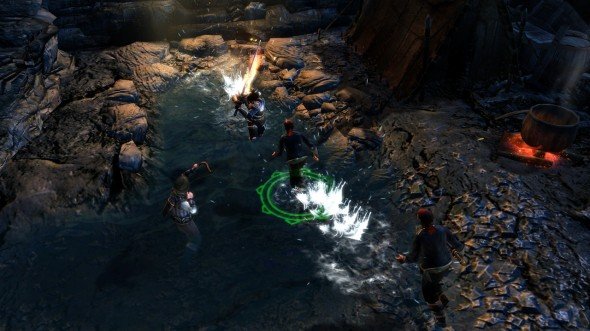
But I'm still curious, because the experience I've had – apart from improved framerates and a crisper depth of field effect, thanks to the beast of a PC next to my feet – has been identical to the consoles. How will the PC mouse and keyboard experience differ?
“When you're playing an action RPG on the PC, when you don't exactly hit the creature that you attack, you then walk to where you clicked. So what we're playing around with right now is that the game is a little more forgiving with the mouse aim, and does that for you. If you're near a creature, it'll swing the sword for you. The PC interface is going to work really well, because of that focus and that perspective.” Yes, but how will it work? Hotkeys? Click to move? “The control scheme will obviously be mouse and keyboard, but it's still going to have the same way of accessing abilities and skills. We probably won't have a one to nine hotkey system.”
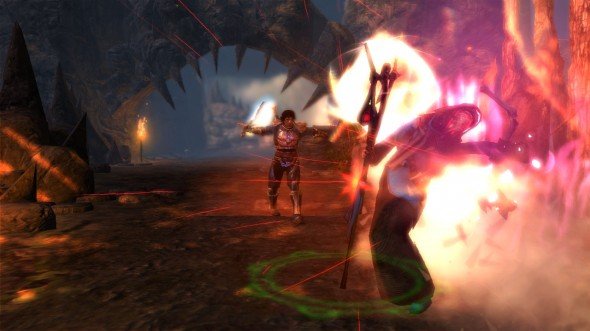
You'll have relationships with other non-hero characters, but it won't be as complicated as, say, Dragon Age, and you'll never upset anyone enough to leave your party. There'll be times at which you'll make decisions that define your character as forgiving, vengeful, loyal or practical, and party members who value that will grow in loyalty.
Urquhart offers a little more detail. “Occasionally, you make a decision that your companions agree with and that aligns with their beliefs. You can't make everyone happy at once. What will you get? It's game level things – so it has effects on your abilities and your characters' abilities. You'll also get some feedback from the characters – there's a mid-range response, and an endgame consequence. You're seeing the effects of that decision throughout the game.”
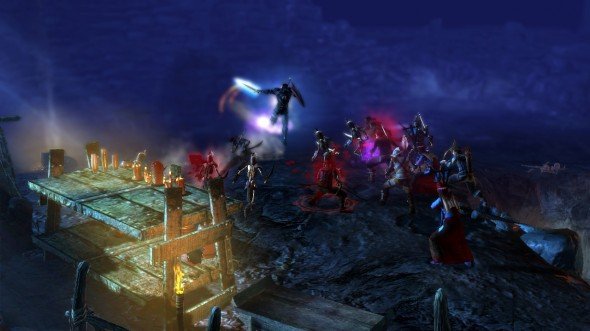
On my first visit to the levelling-up screen, everything's on display – nine skills, three in each stance. It's certainly not as daunting – or compelling – as a big, lovely skill tree. On the other hand, you've got more heroes to try. They're only mentioning two for now – warrior Lucas and the mage Anjali, who we didn't get a chance to play. Urquhart, however, implies – without going so far as to announce – that most fantasy archetypes will be represented.
In terms of multiplayer, Dungeon Siege has never been a competitive game, but the only cooperative play being talked about at the moment is the drop-in, drop-out sofa style. “If you were playing on gamepads on the PC, you can jump in and out in real life, but we're not sure how we're going to do that online with distributions,” explains Urquhart. It would have been slightly more reassuring if he'd just added the word 'yet'. If you do play with a friend on gamepads, they're a guest in your story, and are free to rummage around in your inventory.
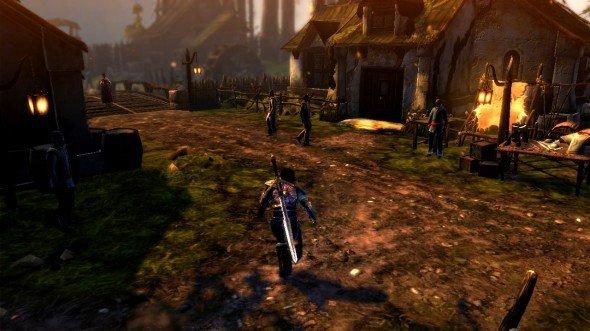
So it's clear that the new Dungeon Siege is much more of an action game. Of course, there's still strategy, but it's not strategy that comes from having a huge range of interacting abilities. It's more a matter of mana management, and learning to deal with the game's special enemies, whose colour-coded auras affect the fight in different ways. Even fighting the regular fodder-mobs is more tactical than chaining a set of regular attacks – from the very beginning, there's a strong element of crowd control and taking the enemy on in a way that effectively uses your current hero's style.
There's a lot to like about Dungeon Siege III. It's an earnest story, told well, and it looks great in Obsidian's beautiful new RPG-oriented Onyx engine. I don't feel like my self-important worries about dumbing down the game have been fully addressed, but I enjoyed my playthrough on a gamepad, and there's more than enough time to address the worrying lack of information about how the PC version will stand out. But for now, with Obsidian's history of solid adopted sequels, it's probably fairest to give them the benefit of the doubt.

